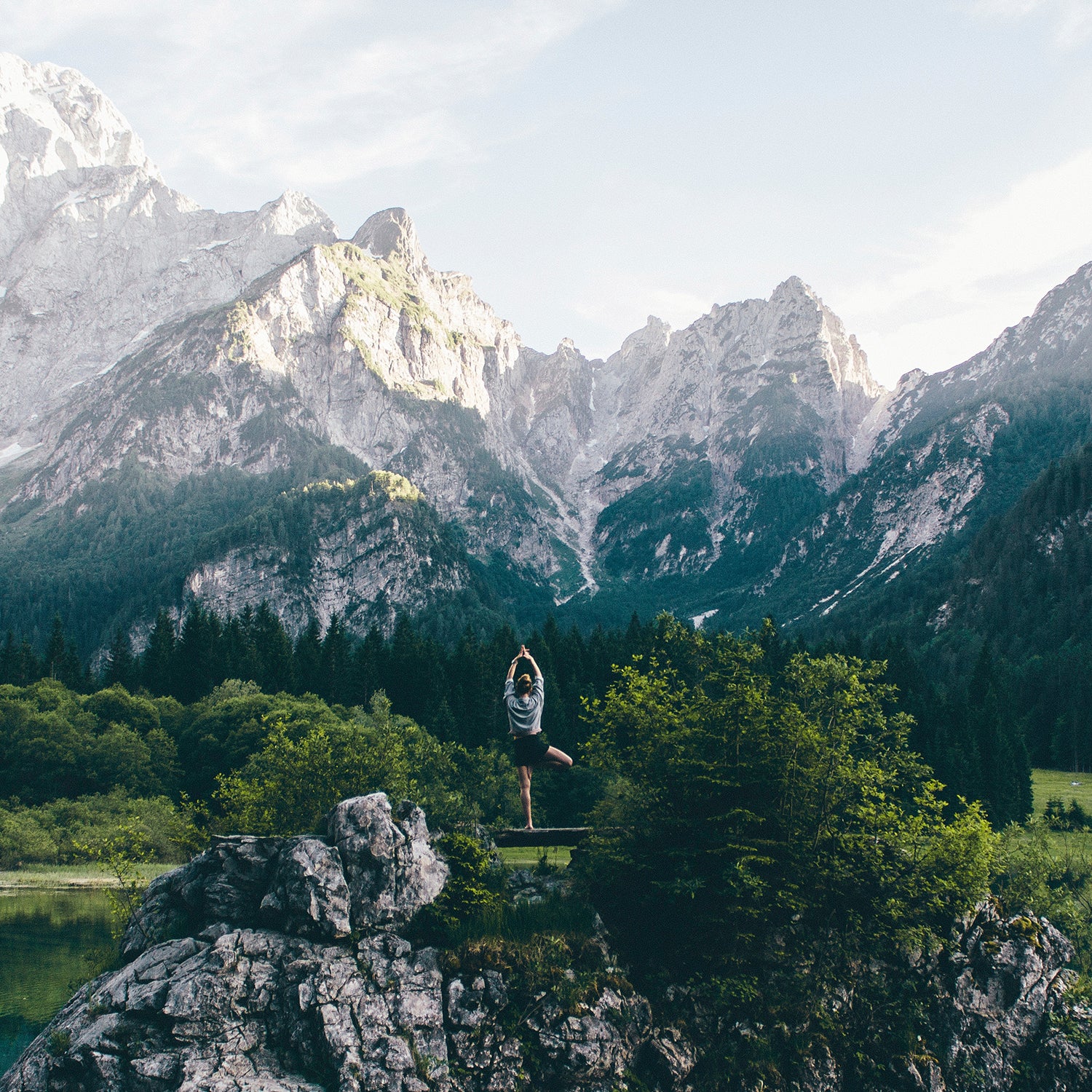I started practicing yoga out of desperation, after I ran myself into a stress fracture and was banned from anything high impact. At the time, I looked at yoga as a way to stay sane. But when my bones finally healed and I got back to skiing, running, and climbing, I saw how yoga directly improved my performance in my sports. I had better balance, a stronger core, and more controlled, fluid movement. I developed a keen sense of where my body was in space and honed breathing techniques to calm down and focus during intense activity.
For athletes, yoga can be a valuable part of a training regimen, helping with injury prevention, recovery, and strength building. But with such a wide out there, yoga can scare away beginners who don’t know where to start. The truth is that whether you’re a skier working to get strong, a mountain biker looking to soothe sore muscles and ease tension, or a surfer hoping to drop into a collected, meditative mental state, there’s a yoga class for you. Here’s our cheat sheet on how to determine which style is right for you.
Vinyasa or Power Yoga
What It Is
Vinyasa means “movement with breath,” but in Western parlance it usually describes vigorous classes that draw you through a series of poses at a faster pace with more continuous movement, or flow. “Power and Vinyasa are fluid descriptors, and what’s powerful about that specific yoga class varies,” says Mary Hayano, manager of the robust program at national yoga chain Planet Granite.
Who Should Try It
If you’re looking to build strength and flexibility and want to leave feeling like you’ve had a bit of a workout, try a power or Vinyasa class. It’s a great way to learn how to safely push your boundaries and when to back off—a tough lesson for athletes who are used to going beyond their limits. “I get many Type As in my class, and for them it’s a lesson in pushing yourself without aggression or the need to seek perfection,” Hayano says. “You have to be willing to get out of your comfort zone and expose what makes you vulnerable.”
Bikram
What It Is
“Bikram is known for being ‘the hot one.’ Rooms are typically heated to 105 degrees with 40 percent humidity. It’s also known for its repetition—every single class is the same 26 postures and two breathing exercises,” says Clare Menzel, a backcountry skier who practiced Bikram for years before switching disciplines. This style of yoga doesn’t focus on flow or the synchronicity of breath and movement, but rather on stillness and engaging muscles by holding single poses for prolonged periods.
Who Should Try It
“You can use this to observe how your body responds to the exact same experience on different days. Then you can try to trace that response back to how you slept or ate or trained and learn lessons about how life choices might make you more sluggish or energetic or impact your ability to maintain focus,” Menzel says. “Aside from learning lessons about how the body works, you’ll likely see benefits in mental conditioning. You push your own limits, but in a safe place.”
Ashtanga
What It Is
Ashtanga is similar to a power Vinyasa class, with classes taught in a very specific sequence, says Hayano, who also trained as an Ashtanga instructor. Six intentionally designed sequences range from basic to complex, but each one qualifies as a powerful posture on its own. Ashtanga offers a full-body strength workout and a head-to-toe stretch, with the added benefit of repetitive classes that make it easy to see how much you’ve improved and identify how your body changes from day to day.
Who Should Try It
Ashtanga is a great class for athletes who are looking to yoga as a supplemental workout, especially if you want to target muscle groups that don’t get much work in your sport of choice. Athletes rehabbing injuries should steer clear, however. “It would be impossible to continue through with injury due to the intensity of the postures even in the first series,” says Jennie Wilkinson, who has been practicing Ashtanga for years.
Iyengar
What It Is
The hallmarks of Iyengar include well-trained teachers (they’re required to have six years of dedicated Iyengar study before they begin teacher training) and keen attention to proper alignment and stability when moving through poses. Teachers are hands-on, helping students find the safest, truest version of a pose—often using props—before moving on to more advanced postures. “Practicioners are encouraged to study anatomy in addition to our work on the mat. That provides the intellectual scaffolding for our understanding of the movement in postures,” says Menzel, who has been a student of Iyengar for the past two years.
Who Should Try It
For someone interested in long-term injury prevention, the nuances of proper yoga technique, and body awareness, Iyengar is a great choice. If you’re injury-prone or actively injured, Iyengar is a safe option, because you’ll get plenty of personalized guidance. And for the body-curious athlete, Iyengar teaches you functional movement patterns. “As you progress into [Iyengar] yoga, you locate the subtle, obscure, or unfamiliar building blocks of your body. You don’t just have a leg or a back—you have particular muscles and particular bones,” Menzel says. “It’s powerful for an athlete to have an awareness of those million pieces, as well as the skill to mobilize them at will. And a firm, focused mind that is aligned with what’s going on in the body is obviously a huge asset in the field for strong and skillful decision-making, navigation of team dynamics, pain management, or endurance through a slog.”
Yin
What It Is
“Yin is a form of yoga developed in Japan. The shapes can resemble some ancient Indian positions but typically have different names. Poses are held three to five minutes, which allows the stretch to get deeper into the body, specifically targeting the ligaments, joints, and fascia,” says Caroline Hill, a Yin yoga instructor based in Whitefish, Montana. “I like to describe the Yin style of yoga as finding an interesting shape to meditate in for a couple of minutes. Sometimes the hardest part of a pose can be to actually stay, breathe, and not fidget. The poses are easy to get into, and once you support yourself—the more props the better—your muscles aren’t working and the whole body can relax and become ooey and gooey. Upon leaving a Yin class, the body, mind, and spirit should feel rejuvenated.”
Who Should Try It
“This mountain-town life is full of extreme people who do extreme things and have extreme fun, but that doesn’t always agree with their bodies. We forget to ‘reward’ our bodies that take us to the tops of mountains and down 2,000-foot runs,” says Hill. “For me, Yin is the answer to silencing my monkey mind and really rejuvenating my body. My main projection of Yin into my daily life is to just recognize how much we demand of our bodies and the need to relax and make time for ourselves. Time to breathe, restore, and thank our bodies for all the places they take us.”
Restorative
What It Is
Restorative yoga is meant to be incredibly gentle. Teachers guide students into restful postures supported by plenty of props, and, as in Yin yoga, postures are held for several minutes at a time. However, restorative yoga doesn’t aim for deep stretching. Rather, it aims to slow the mind, body, and breath to an easy rhythm.
Who Should Try It
Restorative classes are meant for patient, relaxed people—you won’t be getting a workout, and you very well may not get much of a stretch. You should leave feeling calm and collected, so the class is ideal for the scattered mind and the stressed-out body. For the runner putting in 100-mile weeks or the cyclist intentionally ignoring signs of fatigue to get through an intense training regimen, restorative yoga is a perfect rest-day activity. It doesn’t ask anything of tired muscles and creaky joints, but it will give athletes a chance to check in with—and care for—their overworked body.
Kundalini
What It Is
“Kundalini is actually not a Hatha Yoga. Classes include kriyas (combinations of movement and dynamic breathing) instead of asanas [postures], and pranayamas [breathwork] done separately,” Wilkinson says. Students wear all white, and the focus of the class is a release of energy said to be coiled at the base of the spine through breath, chanting, and meditation.
Who Should Try It
“This is for folks looking for that true ‘in your face’ spiritual yoga,” Wilkinson says. Kundalini yoga is niche and, frankly, not all that useful as a training supplement. It’s spiritual and meditative—all mind and no body. It’s fairly widespread, however, so if you come across it at your yoga studio, you’ll know what you’re getting into and can take it as a chance to work on your mental calm and focus, both key skills for a high performer.


